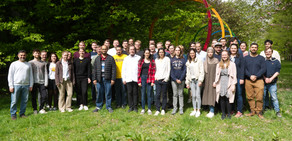News
k-strip: A novel segmentation algorithm in k-space for the application of skull stripping
- Veröffentlichungen
![[Translate to English:] [Translate to English:]](/storages/kroeninger-group-physik/_processed_/6/5/csm_2205_09706_92187db4f4.png)
Abstract:
Objectives: Present a novel deep learning-based skull stripping algorithm for magnetic resonance imaging (MRI) that works directly in the information rich k-space.
Materials and Methods: Using two datasets from different institutions with a total of 36,900 MRI slices, we trained a deep learning-based model to work directly with the complex raw k-space data. Skull stripping performed by HD-BET (Brain Extraction Tool) in the image domain were used as the ground truth.
Results: Both datasets were very similar to the ground truth (DICE scores of 92\%-98\% and Hausdorff distances of under 5.5 mm). Results on slices above the eye-region reach DICE scores of up to 99\%, while the accuracy drops in regions around the eyes and below, with partially blurred output. The output of k-strip often smoothed edges at the demarcation to the skull. Binary masks are created with an appropriate threshold.
Conclusion: With this proof-of-concept study, we were able to show the feasibility of working in the k-space frequency domain, preserving phase information, with consistent results. Future research should be dedicated to discovering additional ways the k-space can be used for innovative image analysis and further workflows.
To the paper:
arXiv: 2202.09706
Our other publications on the subject of statistical methods can be found on the corresponding list of publications.



![[Translate to English:] [Translate to English:]](/storages/zentraler_bilderpool/_processed_/a/a/csm_Kopfbild_TU_Dortmund_von_oben_d7307cbbd8.jpg)